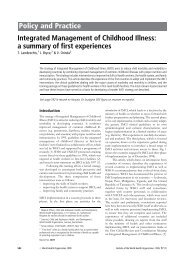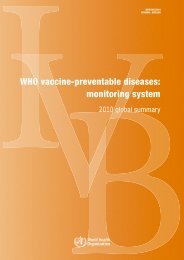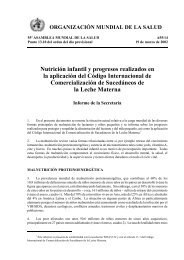IPDE - Extranet Systems - World Health Organization
IPDE - Extranet Systems - World Health Organization
IPDE - Extranet Systems - World Health Organization
Create successful ePaper yourself
Turn your PDF publications into a flip-book with our unique Google optimized e-Paper software.
84 A. W. Loranger<br />
Categories and dimensions<br />
The prevailing systems of disease classification are categoric. They define<br />
the features of disorders, and ideally the categories have points of rarity<br />
with normality and other disorders. Although such nosologies sometimes<br />
fall short of the ideal, their value as shorthand forms of communication<br />
accounts for their widespread acceptance. However, proponents of what<br />
has come to be known as the 'dimensional' approach question the applicability<br />
of the categorical method to personality disorders.14 One argument<br />
is that if PDs are not truly dichotomous in nature, reliability should<br />
improve with the use of dimensions because their measurement would<br />
incorporate more information than that provided by categories alone.<br />
Critics sometimes overlook the fact that categories and dimensions<br />
need not be mutually exclusive, witness their harmonious coexistence in<br />
the classification of mental retardation and hypertension. Following that<br />
tradition, the <strong>IPDE</strong> was designed to provide categorical diagnoses and<br />
dimensional scores based on the categories. The results of the present<br />
study demonstrate the favorable effect of these scores on the reliability<br />
of the <strong>IPDE</strong>. This is illustrated, e.g., by paranoid personality, the disorder<br />
with the least stability. Although the DSM-111-R kappa was only<br />
.24, the stability of the paranoid dimensional score was 0.68 (0.74 with<br />
correction for attenuation). The stability of all of the DSM-III-R dimensional<br />
scores ranged from 0.68 to 0.92 (0.74 to 0.95 corrected), with a<br />
median of 0.77 (0.83 corrected). The corresponding correlations for the<br />
ICD-10 dimensions ranged from 0.65 to 0.86 (0.71 to 0.90 corrected).<br />
with amedian of 0.77 (0.82 corrected).<br />
These findings provide a striking example of the advantage of supplementing<br />
a categorical conclusion about the presence or absence of a specific<br />
PD with dimensional information about the traits that underlie the<br />
decision-making process. The <strong>IPDE</strong> dimensional scores include information<br />
about accentuated normal traits below the threshold required for<br />
a PD. A measure based on pathological traits alone consists of the number<br />
of criteria that a patient meets on a particular disorder. Table 8 (see<br />
chapter 'Results') reveals that this coarser measure is almost invariably<br />
associated with lower reliabilities than the dimensional scores, although<br />
thedifferences are not usually great.<br />
Clinical acceptability and validity of the <strong>IPDE</strong><br />
At the conclusion of the study, a questionnaire concerning the <strong>IPDE</strong> was<br />
completed by all of the inte~ewers and discussed at length at the meeting

















